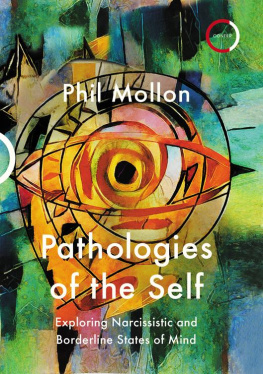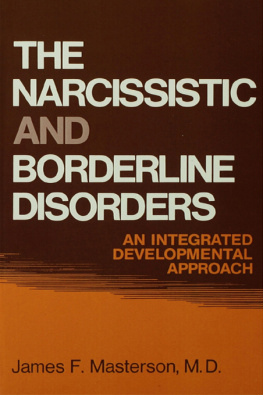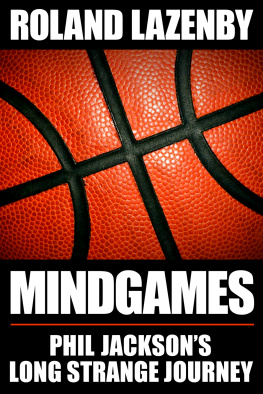Phil Mollon - Pathologies of the Self: Exploring Narcissistic and Borderline States of Mind
Here you can read online Phil Mollon - Pathologies of the Self: Exploring Narcissistic and Borderline States of Mind full text of the book (entire story) in english for free. Download pdf and epub, get meaning, cover and reviews about this ebook. year: 2020, publisher: Confer Ltd, genre: Religion. Description of the work, (preface) as well as reviews are available. Best literature library LitArk.com created for fans of good reading and offers a wide selection of genres:
Romance novel
Science fiction
Adventure
Detective
Science
History
Home and family
Prose
Art
Politics
Computer
Non-fiction
Religion
Business
Children
Humor
Choose a favorite category and find really read worthwhile books. Enjoy immersion in the world of imagination, feel the emotions of the characters or learn something new for yourself, make an fascinating discovery.
- Book:Pathologies of the Self: Exploring Narcissistic and Borderline States of Mind
- Author:
- Publisher:Confer Ltd
- Genre:
- Year:2020
- Rating:5 / 5
- Favourites:Add to favourites
- Your mark:
- 100
- 1
- 2
- 3
- 4
- 5
Pathologies of the Self: Exploring Narcissistic and Borderline States of Mind: summary, description and annotation
We offer to read an annotation, description, summary or preface (depends on what the author of the book "Pathologies of the Self: Exploring Narcissistic and Borderline States of Mind" wrote himself). If you haven't found the necessary information about the book — write in the comments, we will try to find it.
Phil Mollon: author's other books
Who wrote Pathologies of the Self: Exploring Narcissistic and Borderline States of Mind? Find out the surname, the name of the author of the book and a list of all author's works by series.
Pathologies of the Self: Exploring Narcissistic and Borderline States of Mind — read online for free the complete book (whole text) full work
Below is the text of the book, divided by pages. System saving the place of the last page read, allows you to conveniently read the book "Pathologies of the Self: Exploring Narcissistic and Borderline States of Mind" online for free, without having to search again every time where you left off. Put a bookmark, and you can go to the page where you finished reading at any time.
Font size:
Interval:
Bookmark:

- CHAPTER 1
Narcissism, delusion, and the development of the structural self - CHAPTER 2
The realm of the imaginary - CHAPTER 3
The imaginary self - CHAPTER 4
Narcissism and sexual trauma - CHAPTER 5
The roots and structure of narcissistic disturbance - CHAPTER 6
Borderline states
II
To Patrick Casement, for his assistance during
dark days long ago. Without his help I would not
be here now.
For several decades of clinical practice, I have explored and pondered the nature and structure of human identity. This seems such a core aspect of what drives human beings sometimes to gather together and sometimes to go to war. The simple and stark truth appears to be that we are collectively trapped in images. These may be images that we choose, that are given to us, or imposed on us but they are all illusions, albeit seemingly necessary for our functioning in society, and we are inclined to defend them fiercely. They shape how we think, feel, and behave. In our narcissism we seek to preserve a positive, perhaps grandiose, image of self, engaging in slippage of logic and perception, as well as interpersonal manoeuvres to protect this. Sometimes we cruelly and sadistically enslave others to buttress our narcissistic image. Sometimes we have been deeply wounded by the narcissistic manoeuvres of others.
This combination of illusory image and coercion is well captured in the writings of the French psychoanalyst Jacques Lacan: We regard narcissism as the central imaginary relation of interhuman relationships seizing of the other in an image (1956, pp. 9293). Nevertheless, it is, as Kohut (1971) described, the transformation of these illusions that gives rise to core structures of the psyche.
A stable narcissistic structure provides some sanctuary from the pains and terrors of reality, and from the unspeakable horror of the fragmented self. Without this stabilising function, we have the chaos and instability of the borderline state.
Narcissistic and borderline states cannot be separated they are two sides of the same coin. If we look at one side, we see the pathologies of the self; if we look at the other, we see the disturbances of relationships (both internal and external) and disorders of affect regulation. Sometimes one side is to the fore, and sometimes the other and different authors focus on different sides. In this discussion, the emphasis is upon the developmental processes of narcissism since these concern the fundamental structures of the self, upon which all else depends.
Under favourable developmental circumstances, the components of our primitive narcissism are transmuted, via the empathic and supportive responses of caregivers, to form healthy structures of self, as revealed by Kohuts (1971, 1977, 1984) observations and insights. When these processes fail, we have the pathologies of both narcissism and borderline states. Human selves are indeed fragile.
All case examples presented here are composite fictions, comprised of elements inspired by many actual patients.

Everything Ive ever done has been for your benefit, a narcissistic parent may remark to their child. Similar statements may be made in relation to marriages, employment, service to organisations, etc. The claim is that the speaker has been devoted to someone or something beyond any concern for self that is, a claim to be completely lacking in narcissism! Such remarks may be stimulated by an earlier rebuke or criticism. What distinguishes the claim as narcissistic is, first, its completely unrealistic nature, and, second, the speakers apparent belief in its truth. The narcissistic state is thus, in essence, one of delusion a delusion about the speakers inner nature. In more extreme instances, this extends to the perception of external reality.
As Roger Money-Kyrle stated:
... this narcissism is a psychotic trait so pervasive in our species that to possess it is commonly considered to be not merely normal but essential to health something the human race as a whole seems unable fully to outgrow. (1963, pp. 376377)
The narcissistic delusional state is not limited to those who appear overtly grandiose or mad in some way. It is commonplace among the population (even among psychoanalysts!).
All of us may, on occasion, slip into narcissistic modes of thinking and relating (or, rather, non-relating), but a key feature of the more determinedly narcissistic is the persistence of the subtle self-righteous delusion of personal goodness. By contrast, a less narcissistic person, when faced with a criticism, will be more likely to consider its possible truth, to feel some, perhaps temporary, diminishment of self-esteem, to ponder how the reality of a failing might be mitigated or repaired or perhaps, after due consideration, decide the criticism is unjustified. In the mind of the narcissistic person, this process of self-examination is bypassed, and any possible injury to the grandiose self-image (which may be a mostly covert image) is repudiated. Reality is sacrificed to the maintenance of the self-image.
This is a key feature of the thought processes of the narcissistic person. Assertions and conclusions are made not on the basis of reality but on what serves either the persons desires or self-image. Truth is regarded as subjective, varying according to the needs of the moment although the speaker might claim otherwise. In the narcissistic state of mind, perceptual and cognitive processes are distorted, through selective attention and inattention and slippage of logic, such that reality is subordinated to the privileged task of preserving a grandiose self-image. A milder form occurs when it is not so much a grandiose self-image per se that is preserved but a preferred perspective, world view, or belief system. The more malign forms of narcissism involve the coercive recruitment of others in support of the delusional image or belief. This can involve intrusive attempts to take control of the mind of the other (Stark, 2007).
Narcissistic modes of thought are readily observable among some of our more prominent politicians (Coffman, 2017). I will not name them, as they will easily be identifiable by the reader. They are often rather popular and seen as likeable characters reflecting the perennial appeal of those who appear to have managed to preserve narcissistic illusions that the rest of us have largely, albeit reluctantly, abandoned (Freud, 1914c). Sometimes, they manage to seduce us (temporarily) into believing their own illusions. A notable tell-tale feature is the capacity for an essentially childlike slippage of logic combined with a counter- attack of displacement when challenged on a difficult subject all in the service of preserving their private and public grandiose self-image. With some people of quick intelligence, this kind of logical sleight of hand is automatic and immediate, and no doubt seduces their own conscious mind as well as their audience.
Narcissism is also of course a marked feature of young children, whose modes of thought and grandiose fantasies are often wildly at odds with reality. During optimum development, the grandiosity and fantastical thinking gradually give way to a greater accommodation of reality. As Freud (1911b) observed, the pleasure principle is gradually replaced by the reality principle although never completely, and not at all during dreams. When sick, or under great stress or traumatic suffering, our narcissism returns. And some children, such as those with ADHD, may experience greater than normal difficulty in relinquishing grandiose narcissism, which has a drive-like quality that can be hard to restrain when the frontal lobes are not functioning efficiently (Mollon, 2015).
Font size:
Interval:
Bookmark:
Similar books «Pathologies of the Self: Exploring Narcissistic and Borderline States of Mind»
Look at similar books to Pathologies of the Self: Exploring Narcissistic and Borderline States of Mind. We have selected literature similar in name and meaning in the hope of providing readers with more options to find new, interesting, not yet read works.
Discussion, reviews of the book Pathologies of the Self: Exploring Narcissistic and Borderline States of Mind and just readers' own opinions. Leave your comments, write what you think about the work, its meaning or the main characters. Specify what exactly you liked and what you didn't like, and why you think so.











